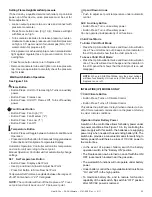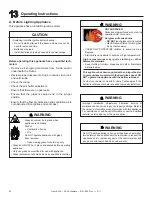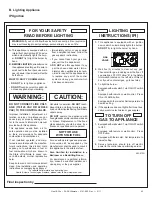
Heat & Glo • SL-36-Ultimate • 2141-900 Rev. i • 5/11
41
H. Grilles and Trim
Install optional marble and brass trim surround kits as de-
sired. Marble, brass, brick, tile, or other noncombustible
materials can be used to cover up the gap between the
sheet rock and the appliance.
Do not obstruct or modify the air inlet/outlet grilles. When
overlapping on both sides, leave enough space so that the
bottom grille can be lowered and the trim door removed.
I. Air Shutter Setting
This appliance has an adjustable air shutter (which con-
trols the primary air) factory set for the minimum vertical
vent run (see Figure 12.10). If your installation has more
than the minimum required vertical vent length, adjust-
ment of the air shutter may be necessary to obtain optimal
fl ame appearance.
This should be adjusted by a quali-
fi ed installer at the time of installation.
By sliding the air shutter handle to the right, you will be
closing the air shutter. To adjust loosen the wing nut. Care
should be taken when adjusting the air shutter so as not
to cause the appliance to soot. If sooting occurs the air
shutter will need to be opened by sliding the handle to the
left. When fi nished tighten wing nut.
Replace the burner by fi rst tipping the front of the burner
up to get the burner neck started into the shutter sleeve
(see Figure 12.14).
Once the neck is in the sleeve, slide the burner all the way
to the left until the orifi ce goes into the burner neck and the
neck contacts the orifi ce holder, and all the way back until
the neck contacts the burner support.
While sliding the burner into position, make sure the pilot
is not pushed aside and it is lined up for reattaching to the
burner (see Figure 12.15).
Figure 12.14
Figure 12.15
Replace the screw in front of the burner to the burner
bracket. Reattach the pilot assembly with two screws.
Reattach the air baffl e, sliding it back to contact the
back of the fi rebox and replacing two screws (see Figure
12.11).
Move the air shutter to the open position and tighten the
wing nut to secure it (see Figure 12.10).















































